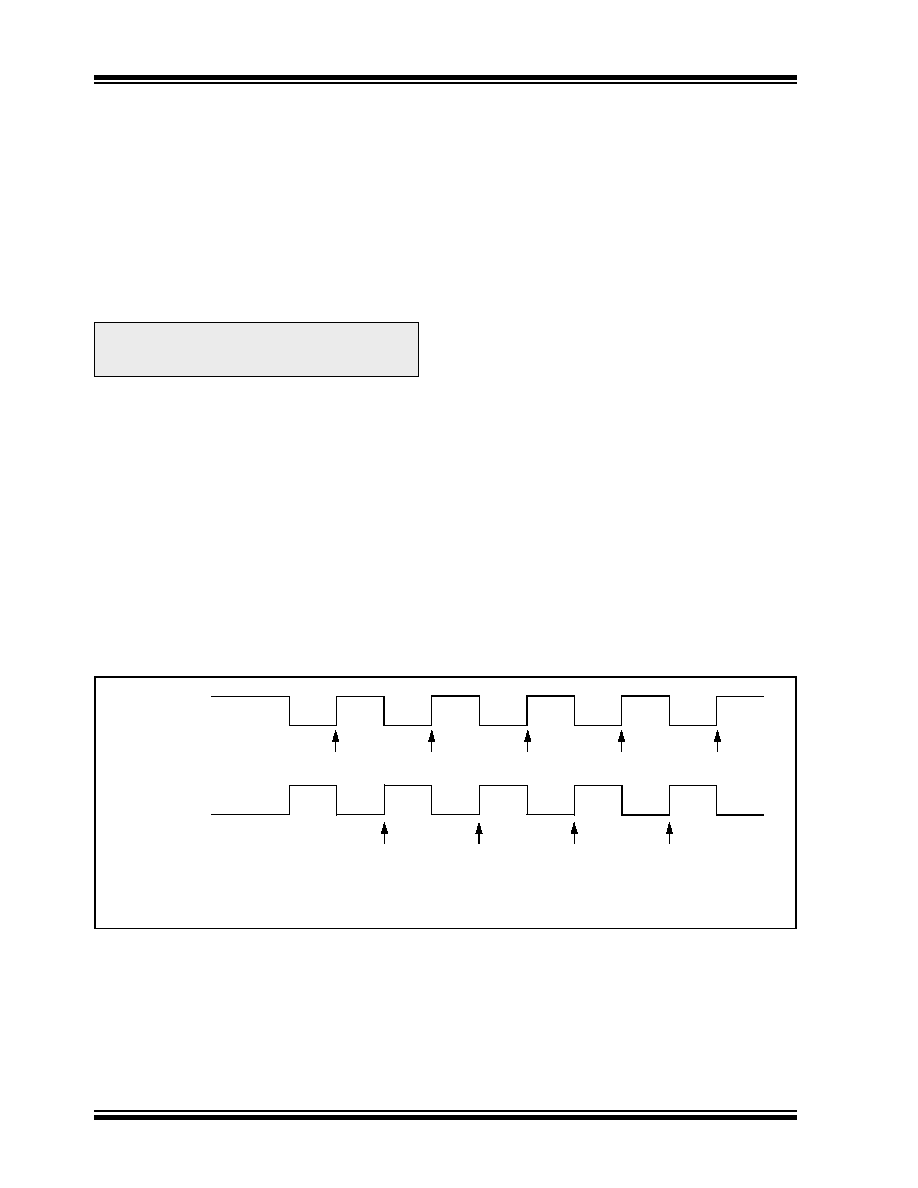- 您现在的位置:买卖IC网 > PDF目录11546 > PIC12F683-E/MD (Microchip Technology)IC PIC MCU FLASH 2KX14 8DFN PDF资料下载
参数资料
| 型号: | PIC12F683-E/MD |
| 厂商: | Microchip Technology |
| 文件页数: | 120/176页 |
| 文件大小: | 0K |
| 描述: | IC PIC MCU FLASH 2KX14 8DFN |
| 产品培训模块: | Asynchronous Stimulus |
| Digi-Key 应用说明: | AN0005 PWM Example with Microchip's CCP Module AN0005 Example Code |
| 标准包装: | 91 |
| 系列: | PIC® 12F |
| 核心处理器: | PIC |
| 芯体尺寸: | 8-位 |
| 速度: | 20MHz |
| 外围设备: | 欠压检测/复位,POR,PWM,WDT |
| 输入/输出数: | 5 |
| 程序存储器容量: | 3.5KB(2K x 14) |
| 程序存储器类型: | 闪存 |
| EEPROM 大小: | 256 x 8 |
| RAM 容量: | 128 x 8 |
| 电压 - 电源 (Vcc/Vdd): | 2 V ~ 5.5 V |
| 数据转换器: | A/D 4x10b |
| 振荡器型: | 内部 |
| 工作温度: | -40°C ~ 125°C |
| 封装/外壳: | 8-VDFN 裸露焊盘 |
| 包装: | 管件 |
| 配用: | AC164326-ND - MODULA SKT PM3 20QFN I3-DB12F683-ND - BOARD DAUGHTER ICEPIC3 |
第1页第2页第3页第4页第5页第6页第7页第8页第9页第10页第11页第12页第13页第14页第15页第16页第17页第18页第19页第20页第21页第22页第23页第24页第25页第26页第27页第28页第29页第30页第31页第32页第33页第34页第35页第36页第37页第38页第39页第40页第41页第42页第43页第44页第45页第46页第47页第48页第49页第50页第51页第52页第53页第54页第55页第56页第57页第58页第59页第60页第61页第62页第63页第64页第65页第66页第67页第68页第69页第70页第71页第72页第73页第74页第75页第76页第77页第78页第79页第80页第81页第82页第83页第84页第85页第86页第87页第88页第89页第90页第91页第92页第93页第94页第95页第96页第97页第98页第99页第100页第101页第102页第103页第104页第105页第106页第107页第108页第109页第110页第111页第112页第113页第114页第115页第116页第117页第118页第119页当前第120页第121页第122页第123页第124页第125页第126页第127页第128页第129页第130页第131页第132页第133页第134页第135页第136页第137页第138页第139页第140页第141页第142页第143页第144页第145页第146页第147页第148页第149页第150页第151页第152页第153页第154页第155页第156页第157页第158页第159页第160页第161页第162页第163页第164页第165页第166页第167页第168页第169页第170页第171页第172页第173页第174页第175页第176页

PIC12F683
DS41211D-page 46
2007 Microchip Technology Inc.
6.7
Timer1 Interrupt
The Timer1 register pair (TMR1H:TMR1L) increments
to FFFFh and rolls over to 0000h. When Timer1 rolls
over, the Timer1 interrupt flag bit of the PIR1 register is
set. To enable the interrupt on rollover, you must set
these bits:
Timer1 interrupt enable bit of the PIE1 register
PEIE bit of the INTCON register
GIE bit of the INTCON register
The interrupt is cleared by clearing the TMR1IF bit in
the Interrupt Service Routine.
6.8
Timer1 Operation During Sleep
Timer1 can only operate during Sleep when setup in
Asynchronous Counter mode. In this mode, an external
crystal or clock source can be used to increment the
counter. To set up the timer to wake the device:
TMR1ON bit of the T1CON register must be set
TMR1IE bit of the PIE1 register must be set
PEIE bit of the INTCON register must be set
The device will wake-up on an overflow and execute
the next instruction. If the GIE bit of the INTCON
register is set, the device will call the Interrupt Service
Routine (0004h).
6.9
CCP Special Event Trigger
If a CCP is configured to trigger a special event, the
trigger will clear the TMR1H:TMR1L register pair. This
special event does not cause a Timer1 interrupt. The
CCP module may still be configured to generate a CCP
interrupt.
In this mode of operation, the CCPR1H:CCPR1L regis-
ter pair effectively becomes the period register for
Timer1.
Timer1 should be synchronized to the FOSC to utilize
the Special Event Trigger. Asynchronous operation of
Timer1 can cause a Special Event Trigger to be
missed.
In the event that a write to TMR1H or TMR1L coincides
with a Special Event Trigger from the CCP, the write will
take precedence.
For more information, see Section on CCP.
6.10
Comparator Synchronization
The same clock used to increment Timer1 can also be
used to synchronize the comparator output. This
feature is enabled in the Comparator module.
When using the comparator for Timer1 gate, the
comparator output should be synchronized to Timer1.
This ensures Timer1 does not miss an increment if the
comparator changes.
For more information, see Section 8.0 “Comparator
FIGURE 6-2:
TIMER1 INCREMENTING EDGE
Note:
The TMR1H:TTMR1L register pair and the
TMR1IF bit should be cleared before
enabling interrupts.
T1CKI = 1
when TMR1
Enabled
T1CKI = 0
when TMR1
Enabled
Note 1:
Arrows indicate counter increments.
2:
In Counter mode, a falling edge must be registered by the counter prior to the first incrementing rising edge of
the clock.
相关PDF资料 |
PDF描述 |
|---|---|
| PIC18LF43K22T-I/MV | IC MCU 8BIT 8KB FLASH 40UQFN |
| V375C48M75BG | CONVERTER MOD DC/DC 48V 75W |
| V375C48M75BF | CONVERTER MOD DC/DC 48V 75W |
| PIC18F43K22T-I/MV | IC MCU 8BIT 8KB FLASH 40UQFN |
| V375C48M75B3 | CONVERTER MOD DC/DC 48V 75W |
相关代理商/技术参数 |
参数描述 |
|---|---|
| PIC12F683-I/MD | 功能描述:8位微控制器 -MCU 3.5KB 128 RAM 6I/O RoHS:否 制造商:Silicon Labs 核心:8051 处理器系列:C8051F39x 数据总线宽度:8 bit 最大时钟频率:50 MHz 程序存储器大小:16 KB 数据 RAM 大小:1 KB 片上 ADC:Yes 工作电源电压:1.8 V to 3.6 V 工作温度范围:- 40 C to + 105 C 封装 / 箱体:QFN-20 安装风格:SMD/SMT |
| PIC12F683-I/MDQTP | 制造商:MICROCHIP 制造商全称:Microchip Technology 功能描述:8-Pin Flash-Based, 8-Bit CMOS Microcontrollers with nanoWatt Technology |
| PIC12F683-I/MF | 功能描述:8位微控制器 -MCU 3.5KB 128 RAM 6 I/O RoHS:否 制造商:Silicon Labs 核心:8051 处理器系列:C8051F39x 数据总线宽度:8 bit 最大时钟频率:50 MHz 程序存储器大小:16 KB 数据 RAM 大小:1 KB 片上 ADC:Yes 工作电源电压:1.8 V to 3.6 V 工作温度范围:- 40 C to + 105 C 封装 / 箱体:QFN-20 安装风格:SMD/SMT |
| PIC12F683-I/MF | 制造商:Microchip Technology Inc 功能描述:8BIT FLASH MCU SMD 12F683 DFN-8 |
| PIC12F683-I/MFQTP | 制造商:MICROCHIP 制造商全称:Microchip Technology 功能描述:8-Pin Flash-Based, 8-Bit CMOS Microcontrollers with nanoWatt Technology |
发布紧急采购,3分钟左右您将得到回复。